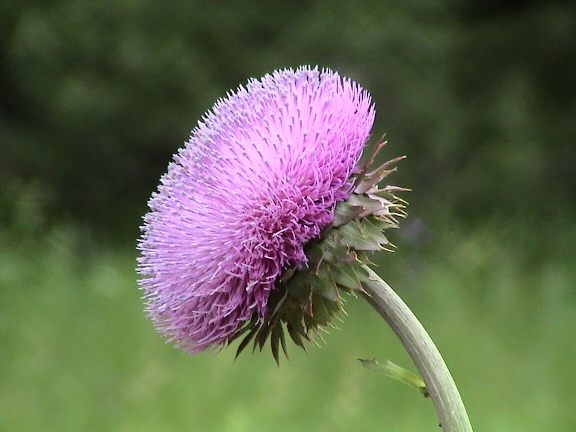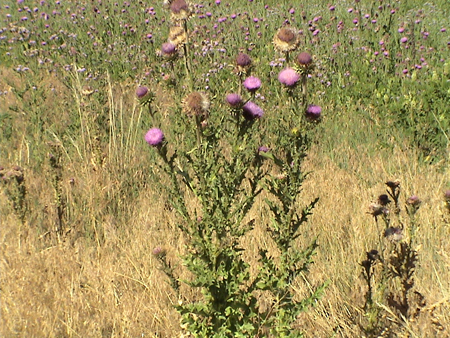Musk Thistle (Carduus nutans L.)
 Identification
Identification
Musk thistle was introduced into the United States from Europe. This plant is considered a noxious weed and is included on the Colorado and the Adams County Noxious Weed Lists. Musk thistle is a biennial, which means its first year of growth is a rosette from a stout, corky taproot. Rosettes can appear in either spring or fall. During the second year, the stem bolts and can grow 2 to 6 feet tall. Musk thistle has waxy, spiny leaves. These spines can cause physical harm to wildlife and humans. Leaves are 3 to 6 inches long and are dark green in color with a prominent midrib.
Musk thistle produces many flowers; one plant may produce 100 or more flowerheads. The nodding flowers are large, 1-1/2 to 2-1/2 inches wide, purple, and surrounded by numerous lance-shaped, spine-tipped bracts. Flowering occurs between late May and early June and set seed in late June/early July.
Musk thistle is usually found as a single plant rather than in dense colonies like Canada thistle and leafy spurge. Musk thistle is found in many county locations such as rangeland, riparian areas, and ditch bank sites.
 Management
Management
The key to controlling musk and Scotch thistle is to prevent seed production since that is the only way these plants reproduce. Each plant is capable of producing up to 20,000 seeds.
Chemical
Herbicides are highly effective in controlling musk and Scotch thistle. Applications should be made in late spring/early summer and again in the fall.
Herbicides that are recommended for use on musk and Scotch thistle, either independently or in combination, are: picloram(Tordon 22K), clopyralid(Transline, Stinger), clopyralid plus 2,4-D(Curtail), chlorsulfuron(Telar), glyphosate(Roundup/Rodeo), dicamba(Banvel), and 2,4-D. Always read and follow label instructions when making any application. Consult your local pesticide dealer, County Weed Supervisor, or Extension Agent for specific recommendations.
Mechanical
Continual mowing or chopping is most effective when musk and Scotch thistle plants are just beginning to flower. Unfortunately, these weeds do not bloom as individual plants at the same time; thus, epeat treatments are necessary. As biennials, these weeds can also be effectively controlled by grubbing, or digging below the crown level. Doing so at the rosette stage is the easiest. Severing the tap root below the soil surface with a shovel can also effectively kill the plant. This should be done in areas where there are only a few plants though as this option is quite labor intensive and time consuming.
Bio-Controls
One insect control agent for musk thistle is the seed head weevil (Rhinocyllus conicus), which is well distributed in the county and spreads on its own. The larval stage of this weevil devours most of the seeds in a head that it infests. This insect alone does not affect total control of musk thistle infestations. The crown weevil (Trichosirocalus horridus) attacks the crown and reduces the flowering potential of musk thistle. When used together, the crown and seedhead weevils provide fair to good control. No insect species effectively controls Scotch thistle. Good grazing practices stimulate grass growth which results in healthy pastures and rangeland. Overgrazed sites result in bare spots which are prime targets for noxious weed infestations.



